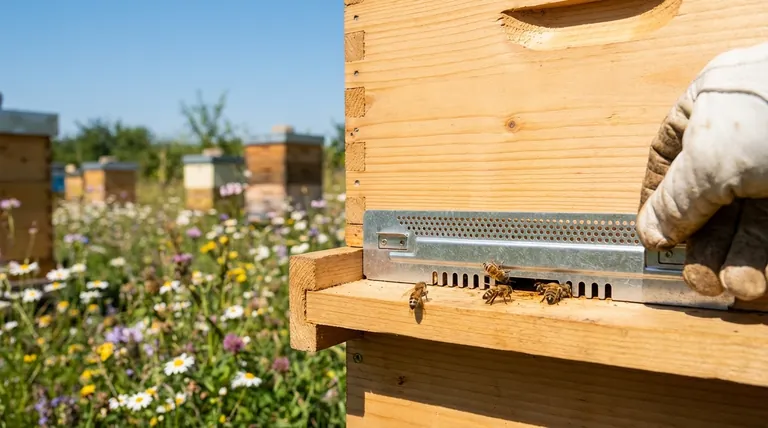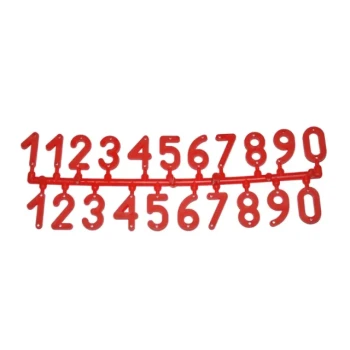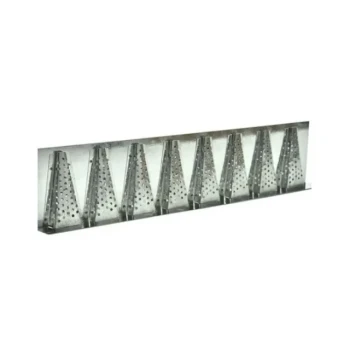At its core, the beehive entrance reducer has two distinct functions. It serves to either shrink the hive opening to a smaller, more defensible size, or to seal the entrance completely. These two configurations allow a beekeeper to manage colony defense, environmental exposure, and logistical tasks like moving the hive.
The entrance reducer is more than just a block of wood; it is a strategic tool for regulating a colony's interaction with the outside world. Mastering its use allows you to adapt the hive's defenses and internal environment in response to seasonal changes, colony strength, and external threats.

The Primary Function: Fortifying the Colony's Defense
A hive's large, main entrance is efficient for a strong colony during a nectar flow, but it can be a significant vulnerability for a weaker one. Reducing the entrance size is a critical defensive maneuver.
Reducing the Entrance Size
The most common use of the reducer is to shrink the opening. This is typically done by placing the wooden cleat with its notched opening facing down, covering most of the hive's entrance but leaving a small passage for the bees.
Preventing Robbing
A smaller entrance is far easier for guard bees to defend. This is crucial for new or weak colonies that can be targeted by stronger hives in the area, a behavior known as "robbing," where invaders attempt to steal the colony's honey stores.
Deterring Predators and Pests
The reduced opening also acts as a physical barrier. It effectively prevents larger predators like mice from entering the hive to nest during winter and can limit access for pests like wasps that prey on the colony.
The Secondary Function: Sealing the Hive
The alternate function of the reducer is to completely close off the hive, turning it into a sealed container for short periods.
Sealing the Entrance Completely
To seal the hive, the reducer is flipped over so the notched opening faces up. This presents a solid, unbroken surface against the hive body, blocking all entry and exit.
Enabling Safe Relocation
This sealed configuration is essential when moving a hive. It ensures the entire colony is contained, preventing bees from escaping during transit or returning to the original location instead of the new one.
Assisting with Hive Treatments
Sealing the hive can also be necessary when performing certain external hive treatments. This ensures the treatment is contained and effective and keeps the bees safely inside during the application.
Understanding the Trade-offs
While beneficial, using an entrance reducer is not without its considerations. Its use must be balanced against the colony's needs.
Risk of Overheating
A reduced entrance severely restricts ventilation. Using a reducer during hot weather can cause the hive to overheat, forcing bees to expend significant energy fanning to cool the interior.
Creating Traffic Jams
For a strong, populous colony during a major nectar flow, a small entrance creates a bottleneck. This can slow down foragers, reduce efficiency, and ultimately limit the amount of honey the colony can produce.
Making the Right Choice for Your Colony
The decision to use an entrance reducer, and in which configuration, depends entirely on the current state and needs of your specific colony.
- If your primary focus is establishing a new or weak colony: Use the reducer with the small opening to help them defend their resources from robbers and pests.
- If your primary focus is preparing for winter in a cold climate: Use the reducer to minimize drafts and prevent mice from entering.
- If your primary focus is moving your hive: Use the sealing function to ensure the entire colony is safely contained for relocation.
- If your primary focus is maximizing honey production in a strong colony: Remove the entrance reducer entirely during the main nectar flow to ensure maximum foraging efficiency.
Properly using an entrance reducer is a key indicator of a beekeeper who is actively and intelligently managing the colony's needs.
Summary Table:
| Function | Configuration | Key Benefit |
|---|---|---|
| Defense | Notched opening facing down | Protects weak colonies from robbing and deters pests like mice and wasps. |
| Sealing | Notched opening facing up | Enables safe hive relocation and assists with external treatments. |
Equip your apiary with professional-grade tools from HONESTBEE. Whether you're a commercial beekeeper managing hundreds of hives or a distributor supplying the industry, our wholesale-focused operations provide the durable, reliable equipment you need for intelligent hive management. Contact our team today to discuss your supply needs and discover the HONESTBEE advantage.
Visual Guide

Related Products
- Beehive Entrance Reducer Guardian Metal Hive Entrance for Bees
- Steel Round Disc Entrance Reducer for Flexzion Bee Hive Nuc Box Gate
- Multi-Functional Rotary Hive Entrance Disc for Beekeeping
- Multi-Functional Sliding Hive Entrance for Beekeeping
- Professional Reversible Beehive Hive Entrance
People Also Ask
- What is the purpose of placing an object in front of the hive entrance after a move? A Guide to Forced Reorientation
- What are the different types of entrance reducers available? A Guide to Protecting Your Hive
- What are the features of the side with oblong holes in the entrance reducer? A Guide to Hive Defense & Health
- What are the different entrance sizes for an 8 or 10-frame Langstroth hive? A Guide to Seasonal Management
- How can a Langstroth hive entrance be adjusted? Mimic Natural Bee Preferences for a Healthier Hive



















